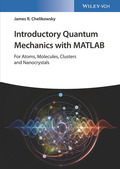Introductory Quantum Mechanics with MATLAB
For Atoms, Molecules, Clusters, and Nanocrystals

1. Edition November 2018
224 Pages, Softcover
2 Pictures
Textbook
Short Description
Filling the need for an accessible approach to the concepts of quantum theory, this book uses MATLAB codes to allow readers to experiment with the numerical techniques described. Unique coverage of such hot topics as clusters, nanocrystals, transitions and organic molecules.
Buy now
Price: 83,90 €
Price incl. VAT, excl. Shipping
Euro prices for Wiley-VCH and Ernst & Sohn titles are only valid for Germany. In EU countries, local VAT applies. Postage will be charged.
Presents a unique approach to grasping the concepts of quantum theory with a focus on atoms, clusters, and crystals
Quantum theory of atoms and molecules is vitally important in molecular physics, materials science, nanoscience, solid state physics and many related fields. Introductory Quantum Mechanics with MATLAB is designed to be an accessible guide to quantum theory and its applications. The textbook uses the popular MATLAB programming language for the analytical and numerical solution of quantum mechanical problems, with a particular focus on clusters and assemblies of atoms.
The textbook is written by a noted researcher and expert on the topic who introduces density functional theory, variational calculus and other practice-proven methods for the solution of quantum-mechanical problems. This important guide:
-Presents the material in a didactical manner to help students grasp the concepts and applications of quantum theory
-Covers a wealth of cutting-edge topics such as clusters, nanocrystals, transitions and organic molecules
-Offers MATLAB codes to solve real-life quantum mechanical problems
Written for master's and PhD students in physics, chemistry, material science, and engineering sciences, Introductory Quantum Mechanics with MATLAB contains an accessible approach to understanding the concepts of quantum theory applied to atoms, clusters, and crystals.
1 Introduction to quantum theory
2 One electron atoms
2.1 The Bohr atom
2.2 The Schrödinger equation
2.3 The electronic structure of atoms and the periodic table
3 Multi-electron systems: atoms and molecules
3.1 The variational principle
3.2 The Hartree approximation
3.3 The Hartree-Fock approximation
4 The electron gas
4.1 The free electron model
4.2 The Thomas-Fermi approximation
4.2 Exchange interactions
5 Density functional theory
5.1 The Hohenberg-Kohn-Sham Theory
5.2 The Kohn-Sham equation
6 Pseudopotential theory
Part 2 Numerical Methods
7 Methods for atoms
7.1 Variational methods
7.2 Integration methods
8 Methods for molecules and clusters
8.1 Basis set methods
8.2 Grid methods
8.3 Diagonalization methods
8.4 Filtering methods
9 MATLABR codes for atoms and molecules
Part 3 Applications
10 Atoms
10.1 Energy levels and orbitals
10.2 Ionization and affinity energies
10.3 Polarizabilities
11 Diatomic and Simple Molecues
11.1 Chemical trends and ionicity
11.2 Energy levels and orbitals
11.3 Binding energies and vibrational modes
12 Clusters
12.1 Special form of matter
12.2 The structure of clusters
12.2 Role of quantum confinement
12.2 Energy levels and orbitals
12.3 Binding energies and vibrational modes
Appendix
A Units
B Matlab codes
Bibliography


